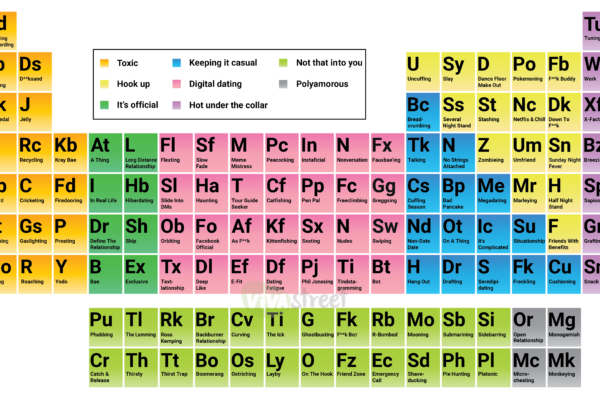The five love languages are a big topic in the dating world. But can you really boil your feelings down into one box? Scientists and psychologists think yes! So, it’s time to learn how you best give and receive love.
Whether you’re looking for a casual fling or a committed partnership, you’ll have a more successful dating experience when using your love language. Let’s make love easy.
Scroll down to learn about your love language and how you should approach dating.
What is a love language?
Let’s start from the top: What is a love language?
The idea of love languages comes from the iconic book “The 5 Love Languages” by Gary Chapman. Since its release in 1992, couples and singles worldwide have empowered their love lives by learning what style they best receive and show love in.
Chapman breaks love down into five prominent styles:
- Words of affirmation
- Quality time
- Acts of service
- Gifts
- Physical touch
Whether they know it or not, most people have a preferred way to give love to their partner and a preference for how they’re loved. Of course, you can be a mix between a few. But you’ll likely be drawn to one or two in particular.
Pro tip: Unsure of your love languages? Try the official love language quiz to find out.

The five love languages and how they affect your dating style
Once you know your love languages, you can start exploring what you need in relationships and how to approach dating.
If you’re in a relationship, your love language can inform how your partner should communicate with you. Likewise, you should learn your partner’s love language and adapt your behaviour to ensure they feel seen and loved.
Here’s a rundown of each and how you should date:
1. Words of affirmation
If your love language is words of affirmation, you value verbal acknowledgements of affection and enjoy hearing how much your partner loves you. This could be lots of “I love you’s”. compliments, clear communication, general appreciation, or verbal encouragement.
Words of affirmation aren’t just an in-person conversation, though. It can also extend to frequent digital communication through texts, DMs, phone calls, or social media memes.
How you should approach dating
Those who prefer words of affirmation should let their partner know they enjoy verbal compliments and affirmations. Whenever you receive verbal praise from your partner, let them know how much you appreciate it, as positive feedback will encourage them to keep going.
2. Quality time
Quality time is all about feeling loved when your partner actively spends time with you and wants to hang out. This doesn’t have to be through formal date nights. Those who enjoy quality time are often happy to chill together or run errands together.
A key aspect of quality time is being present and engaged. This means active listening, eye contact, and no phones. It’s not quality time if your mind is elsewhere or if you’re mindlessly scrolling!
How you should approach dating
If your love language is quality time, you should let your partner know you enjoy being 100% present together. Try to carve out time every week where you spend time enjoying each other’s company, and clearly communicate that this should be time without distractions.
3. Acts of service
Acts of service are all about feeling appreciated when your partner goes out of their way to make your life better. For example, this could be making you tea in the morning, handling errands when you’re busy at work, or bringing you medicine when you’re sick.
Those who enjoy acts of service tend to think actions speak louder than words. It’s also more common for those who are fiercely independent or do a lot for others, as having someone notice your needs and take care of them speaks your language.
How you should approach dating
Having a love language of acts of service can be difficult when you first start dating, as you can’t expect a date to understand your needs when you’re still getting to know each other. However, as the relationship grows, you should express enthusiastic thanks for every act of service and reinforce how important it is to you.
4. Gifts
Receiving gifts is a simple love language, as it’s all about feeling loved and appreciated when someone gives you a physical present.
However, there are some misconceptions about receiving gifts, as it’s not all about monetary value. It’s more about the thought and recognition in the gift-giving process. The gift should be tailored to the person, rather than a generic present.
How you should approach dating
If your love language is receiving gifts, you should let your partner know that you appreciate thoughtful gifts and that they make your day more than anything else. Be sure to remind them that it’s not about expensive gifts, as you don’t want them thinking they need to splurge to make you smile.
5. Physical touch
Lastly, physical touch is all about feeling loved when your partner shows physical affection. This includes holding hands, cuddling, kissing, and sexual intimacy. Physical touch is all about showing love and appreciation with your body.
It’s important to note that even if someone’s love language is physical touch, they still need to consent to the touch.
How you should approach dating
When someone has a physical touch love language, they should clearly let their partner know how and where they enjoy being touched. You must discuss your boundaries and your partner’s boundaries to ensure you’re both on the same page. It’s critical that your partner understands that physical touch isn’t a green light to touch you whenever they feel. It still requires enthusiastic consent.

The takeaway
Understanding your love language can give you valuable insights into your behaviour, making dating slightly easier. When discussing your love language with a partner, use clear communication and practice active listening to ensure they also feel heard. Hopefully, this helps you navigate the dating scene with confidence.
Boost your knowledge with sex and relationship content on the Vivastreet blog today.





